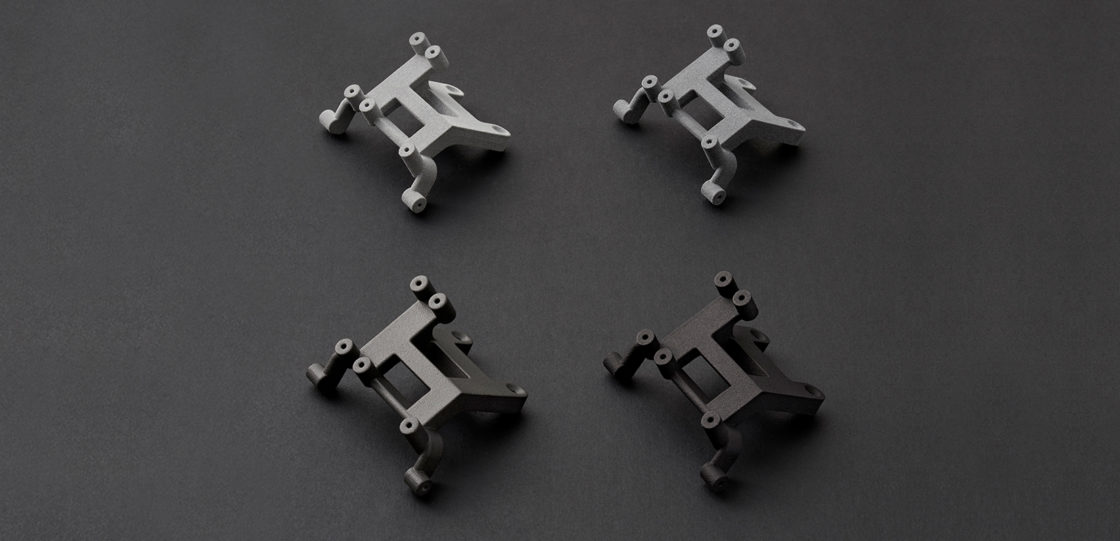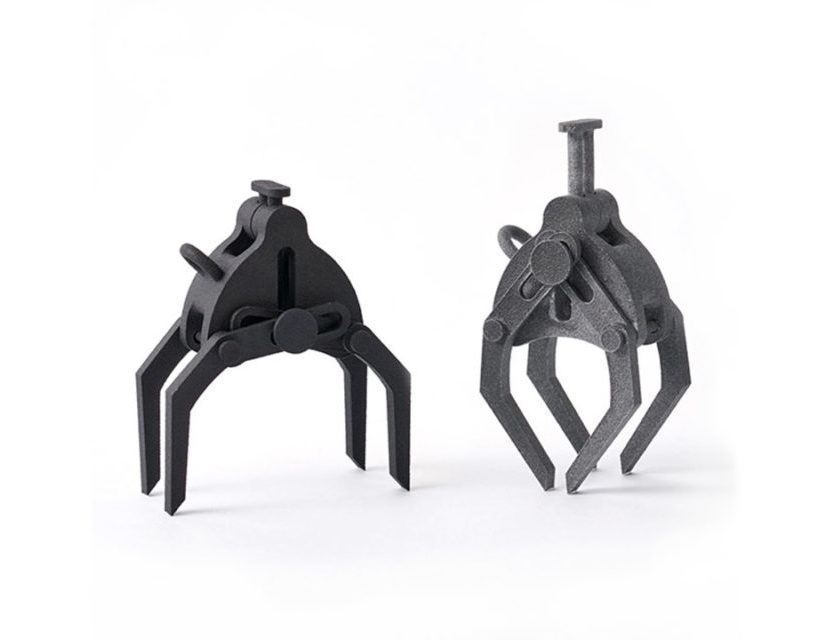
Researching additive manufacturing technology like Multi Jet Fusion 3D printing and 3D printing materials like Multi Jet Fusion Plastic PA12 while in the concept stages helps designers and engineers better fulfill specific project requirements. The process is further perfected once a customer uploads their MJF 3D model to Shapeways for custom 3D printing services where it is analyzed for printability with customized feedback supplied as necessary.
What is Multi Jet Fusion 3D Printing?
HP launched Multi Jet Fusion technology in 2016–and over the years this powerful technology has continued to gain attention. Falling into the broader powder-based category, HP MJF 3D printing surpasses other traditional and additive methods by eliminating the need for laser and binders; instead, MJF relies on two different liquid agents during the 3D printing process to produce parts that are highly isotropic, meaning they are mechanically consistent throughout each structure.
Once 3D printing material is deposited onto the print bed via the recoater, the MJF 3D printing process is initialized as a thermal inkjet array moves back and forth, depositing fusing and detailing agents onto the powder bed, where the nylon powder particles are then melted with thermal heat. The detailing agent is also responsible for cooling and helping create smoother surfaces and sharper detail.
Offering a powerful production solution for Shapeways customers, MJF 3D printing is known for efficiency. While much of that is due to high-quality equipment, the ability to 3D print large volumes of parts also accelerates production. A unique feature in MJF 3D printing allows for the build tray to be removed immediately for post-processing, with another inserted at the same time, permitting ongoing production.
MJF 3D printing technology is faster and more efficient due to the lack of requirements for supports which leads to several important benefits:
- Much greater design freedom and flexibility
- Lack of scarring or blemishes at support sites
- Decreased potential for damage to parts in post-processing
Without any requirements for supports, Shapeways 3D printing engineers nest hundreds of small- to mid-size parts in each build. MJF 3D printing also promotes greater sustainability in additive manufacturing due to the ease in recycling powder from one build to another, with a mix ratio around 80% reused powder and 20% virgin powder. MJF PA12 offers UV stability, and skin safety in accordance with ISO standards.

MJF Additive Manufacturing for Industrial Parts
Advantages to using MJF 3D printing for prototypes and high-performance end parts include higher resolution, greater density, and excellence in mechanical structure. It’s easy to 3D print objects with moving or interlocking parts as they typically offer greater strength in comparison to other manufacturing methods due to effective absorption of thermal energy.
MJF 3D printing is a great fit for production of durable parts featuring fine details and sophisticated geometries. Larger-volume orders, available due to economy of scale, are possible due to the efficient technology and the ability to use proprietary software for smart packing. Some of the most popular uses for MJF 3D printing are replacement parts, snap fits, living hinges, air-tight designs, and industrial components for end-use production.

MJF 3D Printing Materials
Multi Jet Fusion Plastic PA12 (MJF PA12) – Commonly relied on for superior strength and elasticity, MJF PA12 is also chemical- and water-resistant, and suitable for highly functional parts. Because of its outstanding flexibility, MJF PA12 is suited for applications like:
- Architectural designs and home decor
- Drone parts
- Eye frames
- Industrial fixtures
- Mechanical and structural components
- Prosthetics
MJF PA12 is available in both gray and black, featuring a standard finish with a matte surface and slightly grainy texture. Shapeways also provides a black finish with a smooth, non-porous surface created through a physio-chemical vapor smoothing process.
Explore the design guidelines for MJF PA12 here.
This unique material is 40% glass-filled which reduces warping during the printing process and over the product’s life, as well as improving product stiffness and structural integrity. MJF PA12GB 3D printing material is great for flat and large parts that are prone to warping in Nylon 12 [Versatile Plastic] or MJF PA12 Plastic, and for functional parts that require high strength and dimensional accuracy.
Typical uses include:
- Drones
- Housings and cases
- Medical braces
- Robotics
- Tooling
Find out more about the design guidelines for MJF Plastic PA12 Glass Beads here.
Offering the ability to 3D print parts in robust color, this material possesses superior mechanical properties, good dimensional stability, and resistance to impact–as well as chemicals like oil and grease. Defined by the capacity to deform under tensile stress, Nylon 12 Full Color (MJF) is flexible for structures with a thinner design but becomes rigid for use with thicker parts, offering durability and density required for end-use parts.
This nylon 3D printing material is suitable for products like:
- Braces and casts
- Functional prototypes
- Industrial jigs and fixtures
- Medical models
- Moving and interlocking components
- Structural parts and mounts
Nylon 12 Full Color (MJF) is available in both natural and smooth glossy finishes.
Explore the design guidelines for Nylon 12 Full Color (MJF) here.
This material is offered for 3D printing a wide range of MJF parts due to superior resistance to chemicals, low-moisture absorption, and extreme durability. PP is recommended for applications like:
- Electronic devices
- Medical devices like braces and respirator equipment
- Piping, fluid systems, and containers
- Prototypes for automotive test applications
This material is available in gray, with a natural finish.
Explore the design guidelines for Polypropylene here.
Thermoplastic Polyurethane (TPU)
This high-performance 3D printing material enables production of elastomeric functional parts, obtaining results similar to Injection Molding. Parts 3D printed with TPU are flexible, tough, and present high elongation at break and impact resistance for applications like:
- Ducts
- Flexible tubing
- Footwear
- Protective gear
- Seating systems
- Soft grip systems
TPU for MJF 3D printing is available in both natural and smooth finishes.
Explore the design guidelines for Thermoplastic Polyurethane here.
Quality additive manufacturing requires expertise and sophisticated machinery. A successful foundation must be set first though, matching compatible materials and technology to each 3D model and its corresponding applications. With an abundance of 3D printing technology and materials available, the key is in recognizing the advantages of additive manufacturing vs. traditional manufacturing, comparing 3D printing technologies, and sorting through suitable materials, finishes, and post-processing needs.
About Shapeways
Enjoy the benefits of this advanced technology and a wide range of materials from Shapeways for 3D printing your creations with accuracy, complex detail, and no minimum or limits in terms of mass customization or single part orders. Shapeways has worked with over 1 million customers in 160 countries to 3D print over 21 million parts! Read about case studies, find out more about Shapeways additive manufacturing solutions, and get instant quotes here.

